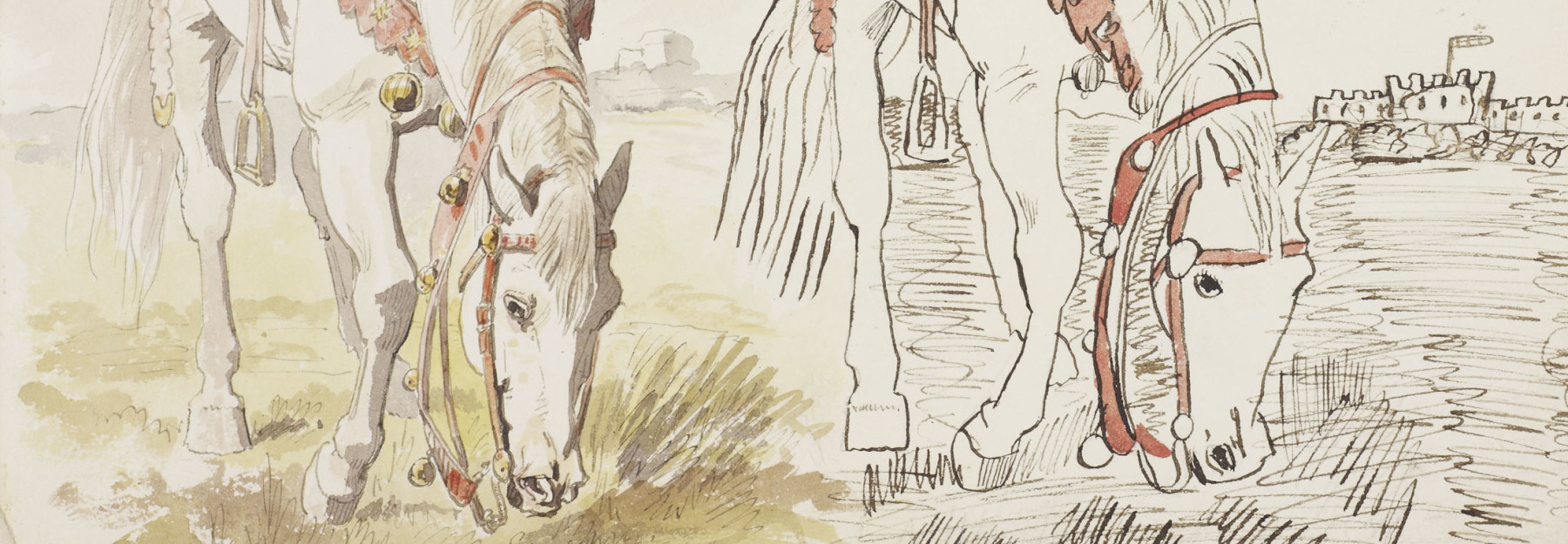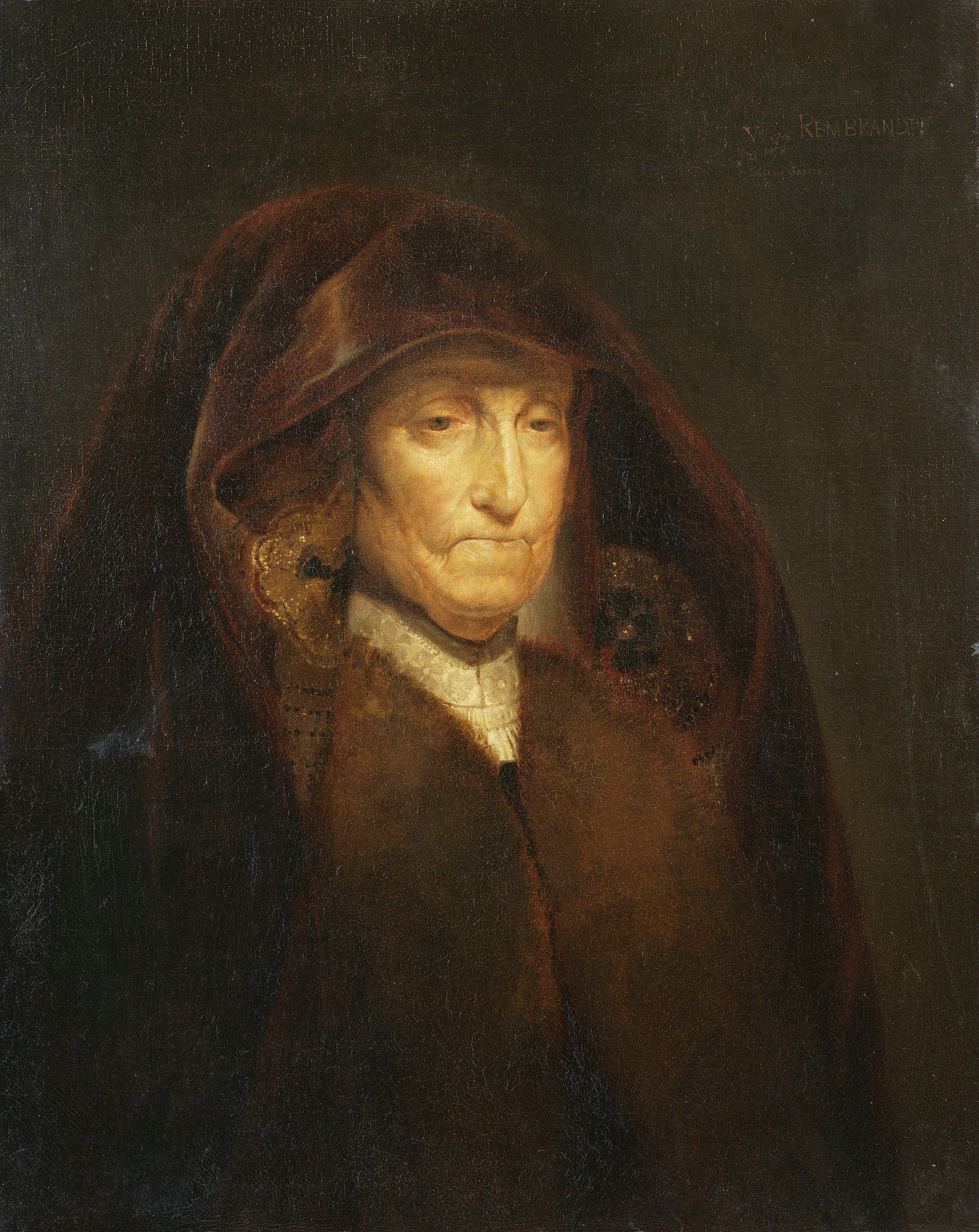
Explore royal copies of Great Masters in the Royal Collection
REMBRANDT VAN RIJN (LEIDEN 1606-AMSTERDAM 1669)
An old Woman called 'The Artist's Mother'
c.1627-9Oil on panel | 61.3 x 47.4 cm (support, canvas/panel/stretcher external) | RCIN 405000
‘The Artist’s Mother’ by Rembrandt is a study in old age by a young, aspiring painter who rapidly gained a reputation for this kind of work before moving to Amsterdam to develop his career as a portraitist and history painter. Executed towards the end of his time in Leiden (c.1629), this painting already reveals Rembrandt’s mastery of precise detail in the treatment of the folds of skin, the sunken eyes, the taut mouth and the prominent nose. The figure wears an exotic deep purple hood with a fur mantle over a dark dress culminating in an embroidered white chemise. The tone of the painting is sombre, but it is offset by the parchment pallor of the skin, the colour of the chemise and the yellow embroidery of the hood. The treatment of the light falling from the right of the composition directly onto the face is masterly in the way it focuses the viewer’s attention on the features.
Rembrandt often used his mother, Neeltgen Willensdr, as a model at the outset of his career both in paintings and prints, but not strictly in terms of conventional portraiture. ‘The Artist’s Mother’ falls into the category of studies of elderly people usually portrayed at bust or half-length and known as 'tronies' (a generic term for ‘face’). Such paintings move beyond the realistic imitation of old age to become exercises in imagination incorporating the use of costume and vivid lighting effects. As such, young artists undertook these paintings in order to establish their reputations and accordingly they were much sought after by collectors. Both Rembrandt’s colleague Lievens and his first pupil Gerrit Dou used the same type of figure in paintings of a similar date.
The painting was presented to Charles I by Sir Robert Kerr (later 1st Earl of Ancram), together with two other works also then thought to be by Rembrandt. These were the first pictures by the artist to enter a British collection. Apart from ‘The Artist’s Mother’, the other paintings were almost certainly 'Self-portrait' (Walker Art Gallery, Liverpool) and 'Young Scholar by a Fire' (now lost) which was probably not by Rembrandt but by his friend and rival, Jan Lievens.
X-rays show that the image has been painted over an earlier portrait of an old man seen the other way up and possibly intended for a biblical figure. Interestingly, the artist also reused the panel in Liverpool to paint his self- portrait.
The painting appears in Pyne's illustrated 'Royal Residences' of 1819, hanging in the King's Dressing Room at Windsor Castle (RCIN 922105).
Catalogue entry adapted from Enchanting the Eye: Dutch paintings of the Golden Age, London, 2004
Rembrandt often used his mother, Neeltgen Willensdr, as a model at the outset of his career both in paintings and prints, but not strictly in terms of conventional portraiture. ‘The Artist’s Mother’ falls into the category of studies of elderly people usually portrayed at bust or half-length and known as 'tronies' (a generic term for ‘face’). Such paintings move beyond the realistic imitation of old age to become exercises in imagination incorporating the use of costume and vivid lighting effects. As such, young artists undertook these paintings in order to establish their reputations and accordingly they were much sought after by collectors. Both Rembrandt’s colleague Lievens and his first pupil Gerrit Dou used the same type of figure in paintings of a similar date.
The painting was presented to Charles I by Sir Robert Kerr (later 1st Earl of Ancram), together with two other works also then thought to be by Rembrandt. These were the first pictures by the artist to enter a British collection. Apart from ‘The Artist’s Mother’, the other paintings were almost certainly 'Self-portrait' (Walker Art Gallery, Liverpool) and 'Young Scholar by a Fire' (now lost) which was probably not by Rembrandt but by his friend and rival, Jan Lievens.
X-rays show that the image has been painted over an earlier portrait of an old man seen the other way up and possibly intended for a biblical figure. Interestingly, the artist also reused the panel in Liverpool to paint his self- portrait.
The painting appears in Pyne's illustrated 'Royal Residences' of 1819, hanging in the King's Dressing Room at Windsor Castle (RCIN 922105).
Catalogue entry adapted from Enchanting the Eye: Dutch paintings of the Golden Age, London, 2004


Painting by Rembrandt
Copy by Princess Victoria




